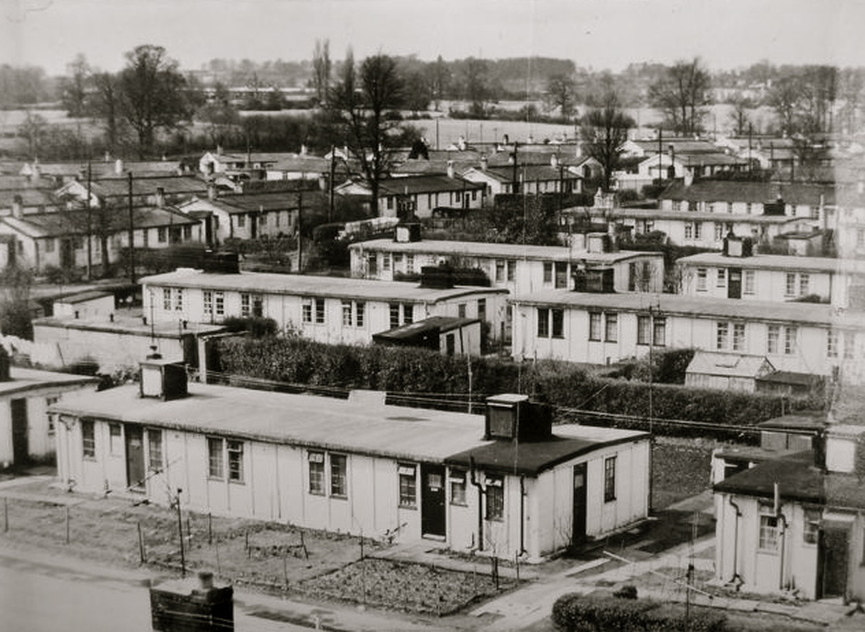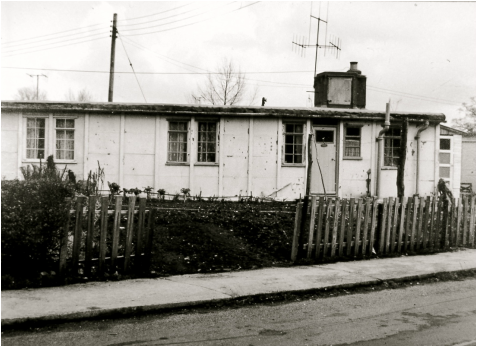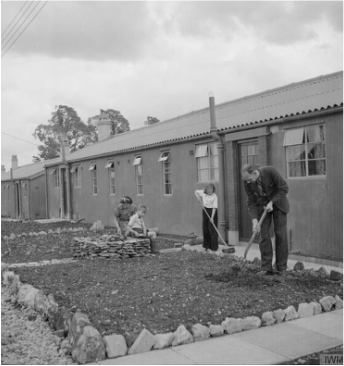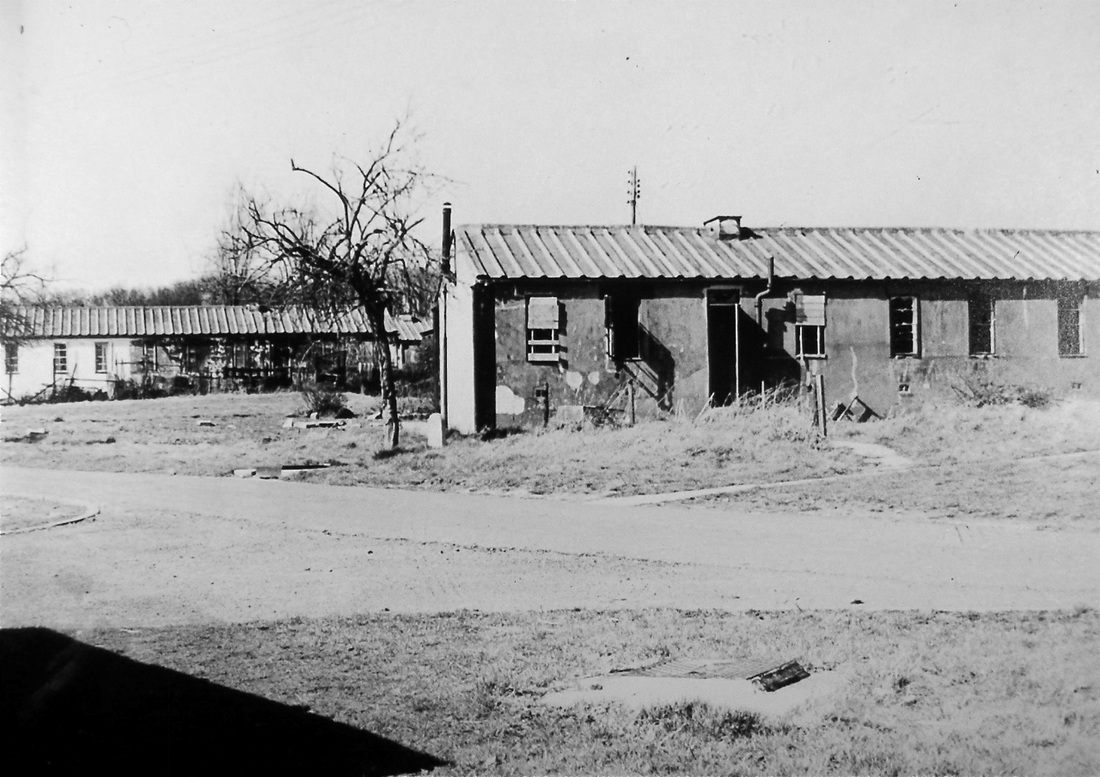|
Boxfields Estate
Ronnie Walker (with additional research and pictures from Ken Oatley) January 2015 We are publishing this article in tribute to the work done by Ronnie Walker to record the history of Box in the Parish Magazine. This item was kindly given to us by Sylvia Walker. Right: Extract of Francis Allen's map of Box dated 1630, which shows Boxfields to the north of Hazelbury Manor. |
Origins
Boxfields is an unusual way of describing an area, so far out from the centre of the main village of Box. It was once a village in its own right. The name is ancient, probably of Saxon origin, and defines the arable, corn-growing fields which ran down from Hazelbury covering the whole eastern side of the village. The area still recalls its medieval past in the name of the road, White Ennox Lane. The name Ennox means land temporarily brought into cultivation from fallow.[1] There are other medieval references in this area, including a Hazelbury field called Innok and Ennox Wood.
But that was centuries ago and the missing village is still within the lifetime of many current residents. Ronnie Walker researched the modern history of Boxfields and wrote the following article a decade ago.
Boxfields is an unusual way of describing an area, so far out from the centre of the main village of Box. It was once a village in its own right. The name is ancient, probably of Saxon origin, and defines the arable, corn-growing fields which ran down from Hazelbury covering the whole eastern side of the village. The area still recalls its medieval past in the name of the road, White Ennox Lane. The name Ennox means land temporarily brought into cultivation from fallow.[1] There are other medieval references in this area, including a Hazelbury field called Innok and Ennox Wood.
But that was centuries ago and the missing village is still within the lifetime of many current residents. Ronnie Walker researched the modern history of Boxfields and wrote the following article a decade ago.
The Hamlet of Boxfields
Building on this estate was started during the 1939-45 war to house the increased population brought into the area for war work including the factories of BAC (Bristol Aeroplane Company) etc. The Air Ministry bought Rudloe Manor in 1940 for £14,000 from Countess Roben (a member of a distinguished Danish family) to house the headquarters of 10 Group Fighter Command.[2] Originally it was planned to have 14,000 workers: 8 hostels at Rudloe and Corsham each housing 1,000 persons; 1,300 in married quarters at Hawthorn; and the remainder bussed in.[3] In the end only half of the plan was actually built because workers from Bristol refused to move.[4]
In 1942 more prefabricated huts were put up in Corsham for Bristol workers made homeless by bombardment and these were subsequently redeveloped as council estates in the 1950s and 1960s.[5] Responsibility for maintenance fell to the Ministry of Works.
There was a total of 260 bungalows, built on both sides of the road, stretching from opposite Tunnel Inn on one side and extending well along the road to Rudloe Fiveways; also some yards down the lane towards Thornypits. Southlands, Woodlands, Waylands, Uplands and Norlands were the street names on this side of the road. Aldhelm Crescent, Portland Crescent and Everley Road were the streets on the other side of the road, starting a little way past the old Boxfields Cottages and also extending well along the road to Fiveways.
They were cheap, emergency houses for wartime needs and after the war for returning soldiers in the face of a severe shortage in the housing stock.[6] Locally, it was a more serious problem because of the underground factory workers who had stayed in Corsham and Box after the war. The council's solution was pre-fabricated houses (prefabs).
These prefabs were very small, often built with pre-cast concrete panels fitted onto a concrete frame. They came pre-painted in magnolia and green but they had many services: a back-boiler to provide central heating from a coal fire and a bathroom with running hot water. They were mainly erected by Irish workers and the present Catholic Church in Pickwick was converted to cater for the builders' religious needs. The prefabs were a temporary solution only intended to last ten years; in the event they lasted over twenty years.
Building on this estate was started during the 1939-45 war to house the increased population brought into the area for war work including the factories of BAC (Bristol Aeroplane Company) etc. The Air Ministry bought Rudloe Manor in 1940 for £14,000 from Countess Roben (a member of a distinguished Danish family) to house the headquarters of 10 Group Fighter Command.[2] Originally it was planned to have 14,000 workers: 8 hostels at Rudloe and Corsham each housing 1,000 persons; 1,300 in married quarters at Hawthorn; and the remainder bussed in.[3] In the end only half of the plan was actually built because workers from Bristol refused to move.[4]
In 1942 more prefabricated huts were put up in Corsham for Bristol workers made homeless by bombardment and these were subsequently redeveloped as council estates in the 1950s and 1960s.[5] Responsibility for maintenance fell to the Ministry of Works.
There was a total of 260 bungalows, built on both sides of the road, stretching from opposite Tunnel Inn on one side and extending well along the road to Rudloe Fiveways; also some yards down the lane towards Thornypits. Southlands, Woodlands, Waylands, Uplands and Norlands were the street names on this side of the road. Aldhelm Crescent, Portland Crescent and Everley Road were the streets on the other side of the road, starting a little way past the old Boxfields Cottages and also extending well along the road to Fiveways.
They were cheap, emergency houses for wartime needs and after the war for returning soldiers in the face of a severe shortage in the housing stock.[6] Locally, it was a more serious problem because of the underground factory workers who had stayed in Corsham and Box after the war. The council's solution was pre-fabricated houses (prefabs).
These prefabs were very small, often built with pre-cast concrete panels fitted onto a concrete frame. They came pre-painted in magnolia and green but they had many services: a back-boiler to provide central heating from a coal fire and a bathroom with running hot water. They were mainly erected by Irish workers and the present Catholic Church in Pickwick was converted to cater for the builders' religious needs. The prefabs were a temporary solution only intended to last ten years; in the event they lasted over twenty years.
They were built by many local councils including those in Box. Some years later Ken Oatley's father, Robert, who worked for Calne & Chippenham Rural District Council, was involved in the demolition of the prefabs and the building of permanent council houses (social housing) in Box.
Some prefabs had asbestos roofs (as Fuller Avenue), others had bituminous asphalt (as the one below left) over breeze block which was supported on a precast concrete-framed structure. They usually had neat, little front gardens for cultivating food which was necessary during wartime shortages and post-war rationing (below right).
Some prefabs had asbestos roofs (as Fuller Avenue), others had bituminous asphalt (as the one below left) over breeze block which was supported on a precast concrete-framed structure. They usually had neat, little front gardens for cultivating food which was necessary during wartime shortages and post-war rationing (below right).
Community and School
Roughly in the centre of the Southlands part of the estate were the Community Centre and the shops. The Community Centre was just that: cinema shows, dances, whist drives, beetle drives, doctor's surgery, political meetings, fetes, parties, etc. It was the heart of the community, and the community was very close-knit. The shops too catered for all needs: a butcher, general provisions, greengrocer, knitting wool, off-Iicence. Later a fish and chip shop were built alongside.
In November 1943, a new temporary school was constructed at Box Hill called Highlands School, sited at the far corner of the Southlands part of the estate, providing a good education for a large number of children, mostly from the estate but including some from homes around the area. It opened under head teacher Mr Marriott and two members of staff. Seventy children attended on the first day and there were facilities for up to 160 from the factory workers. No local village children were permitted to register at first there until all the workers’ children had been placed.
Roughly in the centre of the Southlands part of the estate were the Community Centre and the shops. The Community Centre was just that: cinema shows, dances, whist drives, beetle drives, doctor's surgery, political meetings, fetes, parties, etc. It was the heart of the community, and the community was very close-knit. The shops too catered for all needs: a butcher, general provisions, greengrocer, knitting wool, off-Iicence. Later a fish and chip shop were built alongside.
In November 1943, a new temporary school was constructed at Box Hill called Highlands School, sited at the far corner of the Southlands part of the estate, providing a good education for a large number of children, mostly from the estate but including some from homes around the area. It opened under head teacher Mr Marriott and two members of staff. Seventy children attended on the first day and there were facilities for up to 160 from the factory workers. No local village children were permitted to register at first there until all the workers’ children had been placed.
|
Later on, the estate came under the auspices of the local council and young newly- weds started their married lives in the bungalows. However, it had always been the intention that the land should revert to agriculture and the estate was finally demolished some years ago in the mid 1960s. Still being put to a good use, some of the remains were transported to Box and used for building up the land at the bottom of the Recreation Ground.
The residents of the estate moved in different directions: some to Box, some to the newly built up Rudloe Estate and some to Corsham. Left: The prefabs at the end of an era |
There is a fabulous depiction of life in the prefabs written by Rosie McNamara (nee Feeney) and another by Mike Pearce, including some astounding photographs of the area at that time. You can read them at Paul Turner's website of Rudloe Scene at:
http://www.rudloescene.co.uk/archive-1/boxfields
http://www.rudloescene.co.uk/archive-1/boxfields
And there will be more about the fascinating Boxfields area in a future issue.
References
[1] JEB Gover, Allen Mawer, and FM Stenton, The Placenames of Wiltshire, 1939, Cambridge University Press, p 86 and 134
[2] Countryside Treasures, p.27
[3] NJ McCamley, Secret Underground Cities, p.160-4
[4] VCH, Vol IV, p.250 and NJ McCamley, Secret Underground Cities, p.194-9
[5] CJ. Hall, Corsham: An Illustrated History, 1983, pub CJ. Hall, p.30
[6] There was a succession of government acts of parliament, such as the Housing (Temporary Accommodation) Act implemented in 1945.
References
[1] JEB Gover, Allen Mawer, and FM Stenton, The Placenames of Wiltshire, 1939, Cambridge University Press, p 86 and 134
[2] Countryside Treasures, p.27
[3] NJ McCamley, Secret Underground Cities, p.160-4
[4] VCH, Vol IV, p.250 and NJ McCamley, Secret Underground Cities, p.194-9
[5] CJ. Hall, Corsham: An Illustrated History, 1983, pub CJ. Hall, p.30
[6] There was a succession of government acts of parliament, such as the Housing (Temporary Accommodation) Act implemented in 1945.




